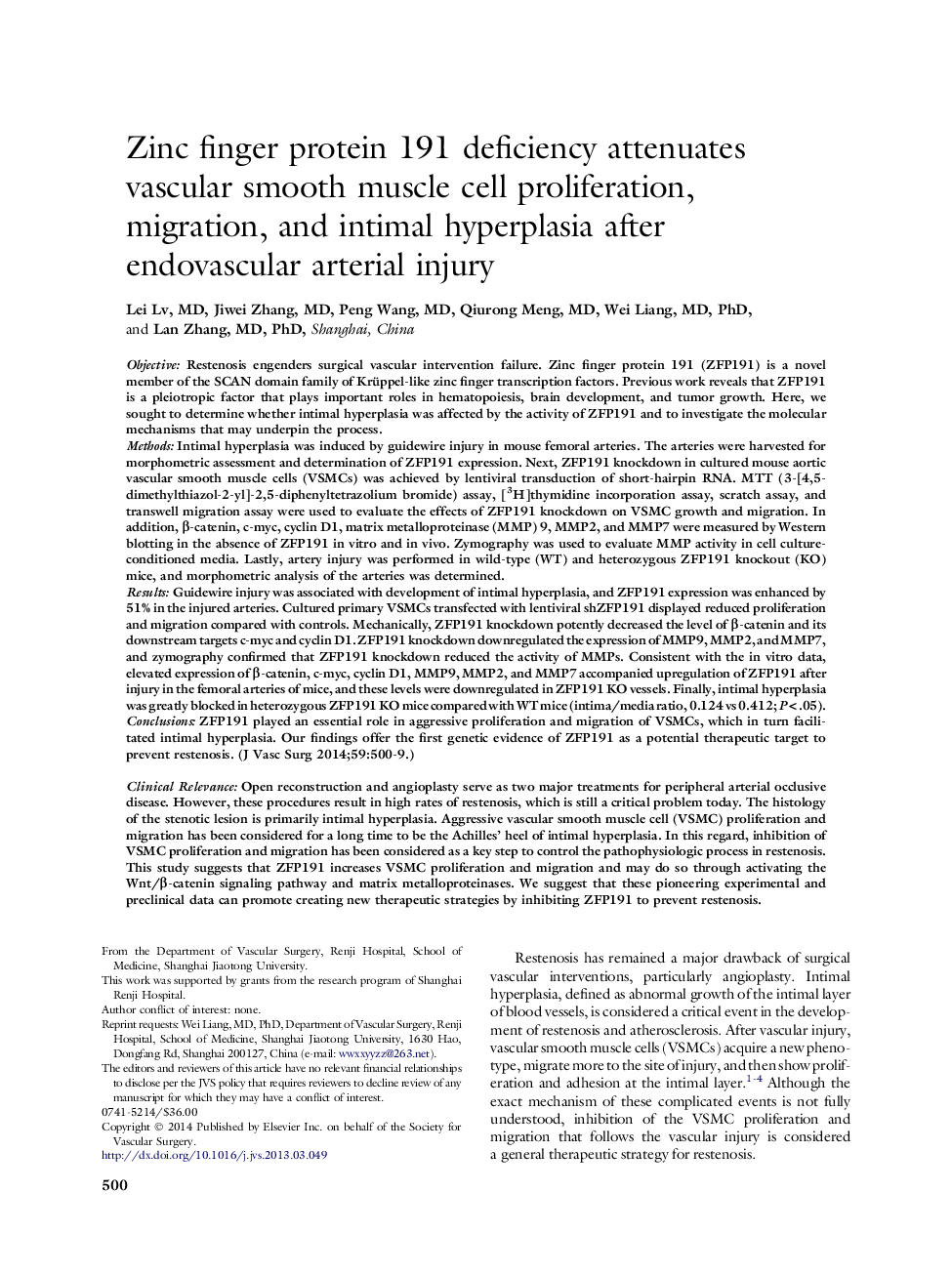| Article ID | Journal | Published Year | Pages | File Type |
|---|---|---|---|---|
| 2988944 | Journal of Vascular Surgery | 2014 | 10 Pages |
ObjectiveRestenosis engenders surgical vascular intervention failure. Zinc finger protein 191 (ZFP191) is a novel member of the SCAN domain family of Krüppel-like zinc finger transcription factors. Previous work reveals that ZFP191 is a pleiotropic factor that plays important roles in hematopoiesis, brain development, and tumor growth. Here, we sought to determine whether intimal hyperplasia was affected by the activity of ZFP191 and to investigate the molecular mechanisms that may underpin the process.MethodsIntimal hyperplasia was induced by guidewire injury in mouse femoral arteries. The arteries were harvested for morphometric assessment and determination of ZFP191 expression. Next, ZFP191 knockdown in cultured mouse aortic vascular smooth muscle cells (VSMCs) was achieved by lentiviral transduction of short-hairpin RNA. MTT (3-[4,5-dimethylthiazol-2-yl]-2,5-diphenyltetrazolium bromide) assay, [3H]thymidine incorporation assay, scratch assay, and transwell migration assay were used to evaluate the effects of ZFP191 knockdown on VSMC growth and migration. In addition, β-catenin, c-myc, cyclin D1, matrix metalloproteinase (MMP) 9, MMP2, and MMP7 were measured by Western blotting in the absence of ZFP191 in vitro and in vivo. Zymography was used to evaluate MMP activity in cell culture-conditioned media. Lastly, artery injury was performed in wild-type (WT) and heterozygous ZFP191 knockout (KO) mice, and morphometric analysis of the arteries was determined.ResultsGuidewire injury was associated with development of intimal hyperplasia, and ZFP191 expression was enhanced by 51% in the injured arteries. Cultured primary VSMCs transfected with lentiviral shZFP191 displayed reduced proliferation and migration compared with controls. Mechanically, ZFP191 knockdown potently decreased the level of β-catenin and its downstream targets c-myc and cyclin D1. ZFP191 knockdown downregulated the expression of MMP9, MMP2, and MMP7, and zymography confirmed that ZFP191 knockdown reduced the activity of MMPs. Consistent with the in vitro data, elevated expression of β-catenin, c-myc, cyclin D1, MMP9, MMP2, and MMP7 accompanied upregulation of ZFP191 after injury in the femoral arteries of mice, and these levels were downregulated in ZFP191 KO vessels. Finally, intimal hyperplasia was greatly blocked in heterozygous ZFP191 KO mice compared with WT mice (intima/media ratio, 0.124 vs 0.412; P < .05).ConclusionsZFP191 played an essential role in aggressive proliferation and migration of VSMCs, which in turn facilitated intimal hyperplasia. Our findings offer the first genetic evidence of ZFP191 as a potential therapeutic target to prevent restenosis.
Clinical RelevanceOpen reconstruction and angioplasty serve as two major treatments for peripheral arterial occlusive disease. However, these procedures result in high rates of restenosis, which is still a critical problem today. The histology of the stenotic lesion is primarily intimal hyperplasia. Aggressive vascular smooth muscle cell (VSMC) proliferation and migration has been considered for a long time to be the Achilles' heel of intimal hyperplasia. In this regard, inhibition of VSMC proliferation and migration has been considered as a key step to control the pathophysiologic process in restenosis. This study suggests that ZFP191 increases VSMC proliferation and migration and may do so through activating the Wnt/β-catenin signaling pathway and matrix metalloproteinases. We suggest that these pioneering experimental and preclinical data can promote creating new therapeutic strategies by inhibiting ZFP191 to prevent restenosis.
